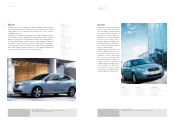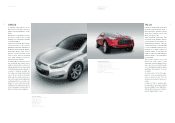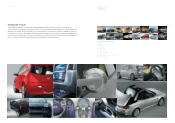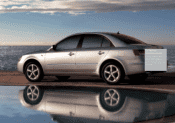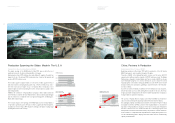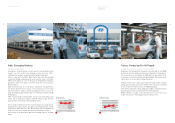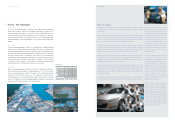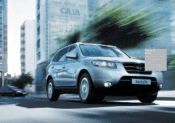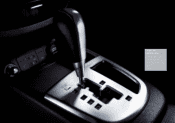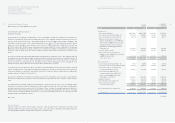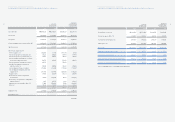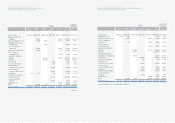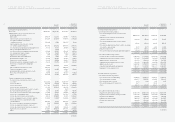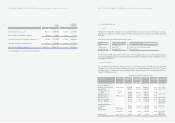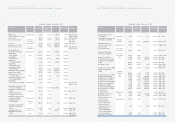Hyundai 2005 Annual Report Download - page 26
Download and view the complete annual report
Please find page 26 of the 2005 Hyundai annual report below. You can navigate through the pages in the report by either clicking on the pages listed below, or by using the keyword search tool below to find specific information within the annual report.
50
Hyundai Motor Company
Annual Report 2005
>>Sublime Drive
49
Environmental Advancements
Hyundai Motor Company
Environmental Advancements
In 2005 Hyundai Motor Company Chairman and CEO, Chung Mong-Koo launched
our new corporate vision ‘Innovation for Humanity’. This vision was designed to cre-
ate new benchmarks against which all Hyundai operations would be judged.
Chief among these is care and respect for the environment without which there
would be no Hyundai and no humanity. The challenge presented to corporations,
governments and to all people is to find ways to live in harmony with the natural
world and, wherever possible, turn back the planet’s biological clock to a cleaner,
greener world.
As an automobile manufacturer the number one priority of our environmental strate-
gy is the commercialization of eco-friendly vehicles. Hyundai Motor Company con-
tinues to work towards this end with our electric and hybrid car developments,
advancements in diesel engine technologies and our continuing commitment to
end-of-life vehicle disassembly and recycling technologies.
Our financial investment in developing, commercializing and maintaining these tech-
nologies continues in recognition that, for the survival of our company, let alone the
planet, the future must be green.
Developed FGV-1
1995 1999 2000 2001 2002 2004 2005
Developed FGV-2 / Developed Elantra hybrid vehicle
Participated in California fuel cell partnership /
Developed Accent hybrid vehicle / Developed County hybrid vehicle /
Developed Santa Fe fuel cell electric vehicle
Accomplished 350 bar hydrogen charge for the
first time in the world (CaFCP)
Developed Getz hybrid vehicle /
Participated in the fuel cell
commercialization project in Japan
The Ministry of Environment’s demonstration of the Getz hybrid vehicle /
Developed the Tucson fuel cell electric vehicle / Validation project of the fuel cell car operation
commissioned by the U.S.A Department of Energy (DOE)
Developed the new Accent hybrid vehicle /
Developed the Tucson fuel cell electric vehicle with
cold startability / Completed the construction of Chino
Hydrogen Energy Station in the U.S.A
1. Hydrogen Fueling Pump
2. Hydrogen Fueling Station in California Tucson fuel cell vehicles to the Alameda-Contra Costa Transit District
in California, as a part of a project commissioned by the U.S.A
Hydrogen Fueling Station in California
As part of the Hydrogen Fleet & Infrastructure
Demonstration and Validation Project, Hyundai
Motor Company completed the construction of its
first hydrogen fueling station located at the
Hyundai & Kia America Technical Center in Chino,
California. A state of the art facility, the fueling sta-
tion produces 15kg of natural gas per day.
Daily fueling capacity is 30 vehicles and fueling
takes roughly 2 minutes to complete. Working in
cooperation with Chevron Texaco, Hyundai Motor
Company has made plans to build more hydrogen
fueling stations in California and other states.
Hyundai Delivers Fuel Cell Vehicles for Exhaustive
Test Program
In December 2005 Hyundai Motor Company deliv-
ered the first of 10 Hyundai Fuel Cell Electric
Vehicles (FCEV) to the Alameda-Contra Costa
Transit District (AC Transit) in Emeryville, California.
The ceremony took place at AC Transit’s
Emeryville Bus Division and marked the beginning
of a five-year demonstration and validation project
designed to evaluate fuel cell vehicles and hydro-
gen infrastructure technologies.
“Hyundai’s partnership with AC Transit represents
the first time that a third-party has been involved in
our fuel cell vehicle research, and it marks another
milestone in our effort to bring this technology to
commercialization,” said Dr. Won Suk Cho, presi-
dent, Hyundai America Technical Center, Inc.,
which is responsible for alternative fuel research in
the U.S.A. “Our vehicles will be operating in
real-world working environments everyday proving
the viability of this technology.”
In April 2004 Hyundai, Chevron Corporation and
UTC Power were awarded a U.S.A Department of
Energy grant to support research into hydrogen-
powered fuel cell technology for automotive
applications. The grant represents U.S.A govern-
ment faith in Hyundai Motor Company to deliver
on its environmental goal of building better and
cleaner vehicles.
Hybrid Electric Vehicle (HEV)
Combines the conventional power-train with the
electric motor and battery system. Offers reduced
improved energy efficiency (greater than 50
percent improvement in fuel economy) and a
reduction in emissions (greater than 15 percent
reduction in fuel emissions). Currently in operation
as Hyundai Accent HEV and Getz HEV. Hyundai
Sonata HEV will be produced from 2007.
Fuel Cell Electric Vehicle (FCEV)
FCEV uses hydrogen, methanol or natural gas as
its main fuel source in reaction with oxygen,
resulting in the outflow of electricity. The FCEV
offers greater re-fueling ease, increased power
and superior performance to its predecessor the
Electric Vehicle (EV). Currently in operation are
Santa Fe FCEV and Tuscon FCEV which features
a start up ability in sub-zero weather.
Gasoline Controlled Auto Ignition (CAI) Engine
Hyundai Motor Company is developing the CAI
Engine to reduce NOx emissions produced from
gasoline engines. The CAI reduces NOx emissions
by over 90 percent compared to existing
conventional engines. In addition, fuel efficiency
improves by 15 percent when the Gasoline Direct
Injection System is applied to the Gasoline CAI
engine
Homogenous Charge Compression Ignition
(HCCI)
Although diesel powered engines achieve higher
efficiency and low emissions, internal combustion
chamber related problems result in excess NOx
emissions. To combat this Hyundai Motor
Company is developing the HCCI Engine to
reduce NOx emissions.
ELV Disassembly Plant
In November 2004, Hyundai Motor Company
completed the construction of the ELV Disassembly
Plant. The plant includes state of the art disposal
equipment and related technologies and has a
maximum recycling capacity of 4,000 vehicles.
Comprising eight phases, the plant includes a
continuous flow disassembly system along with a
system which monitors recycling.
Vehicle Recycling
Hyundai Motor Company is developing various
waste parts recycling technologies for use in the
production of new vehicles. In line with its plastic
and rubber recycling initiatives, Hyundai Motor
Company recycles vehicle carpets and seating
foam and reuses parts in trunk trim and noise
reducing padding parts. In addition, Hyundai
Motor Company will introduce a new recycling
system for waste bumpers from 2005. The system
allows for large scale re-circulation of materials
from used bumpers and for the elimination of
disposal wastes through recycling.
Catalysts Recycling
Platinum Group Metals (PGM) are used as the
main catalyst to refine petroleum and purify
emissions. Due to rising global demand and the
relatively high cost of PGM, recycling initiatives
have been set as a major priority. In partnership
with suppliers, Hyundai Motor Company estab-
lished a joint venture which became the first
domestic environmentally friendly PGM recycling
company. This joint venture allows for Hyundai
Motor Company to achieve cost savings and
reductions and continued progress in the
domestic automobile industry.
1 2


